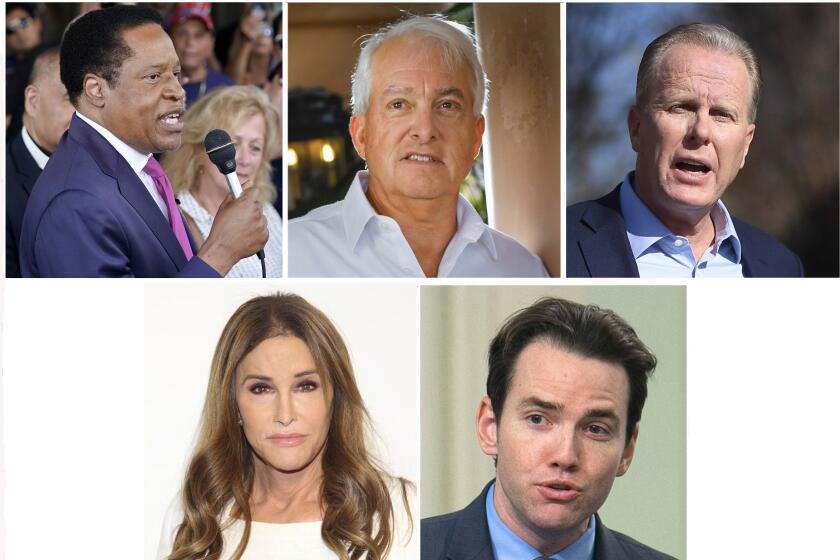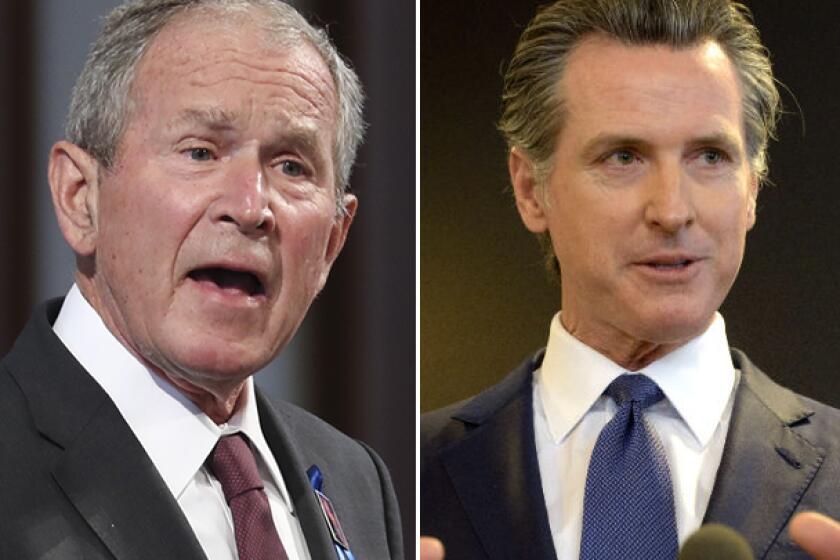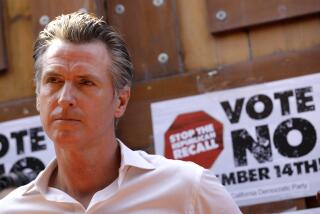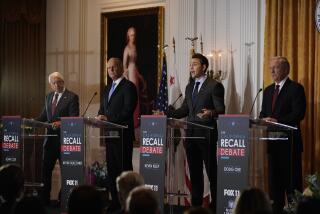Column: Why Newsom may prefer early California recall election vote

Late summer brings many splendors to California. Sultry nights. Pennant drives. Leaves flaming crimson and yellow in the Sierra.
It might also bring just the second vote ever to oust a governor before his term is ended.
As things increasingly look up for Gavin Newsom — businesses reopening, COVID-19 waning, schools returning to in-person instruction — it’s now likely a decision on his political fate will come closer to Labor Day than Thanksgiving. That’s earlier than originally anticipated and reflects growing Democratic confidence that Newsom will survive a recall attempt.
A recent poll by the nonpartisan Public Policy Institute of California showed what others have found: A healthy majority of those questioned oppose the governor’s removal. Democrats are strongly against the effort, Republicans are strongly in favor and independents are nearly evenly split.
In a state with far more Democrats and independents than Republicans, that’s not a winning formula for those seeking to chase Newsom from office ahead of the November 2022 election.
More significantly, the poll found little difference from an opinion survey conducted in March. Those fixed attitudes and a limited appetite for news coverage suggest the recall hasn’t really captivated voters like the one in 2003, which drew worldwide attention and a color wheel of candidates highlighted by the presence of mega-movie star Arnold Schwarzenegger.
This time we’ve got Caitlyn Jenner and a bear that John Cox is schlepping around the state.
As the effort to recall California Gov. Gavin Newsom moves forward, candidates line up to replace him.
All that could change, which is why Newsom would probably schedule a snap election for tomorrow if it were in his power. It’s not. There are target dates and election guidelines written into state law.
But it’s not as if those rules were carved in stone tablets handed down from Mt. Whitney. There is a certain amount of flexibility built into the process and you can be certain Newsom’s fellow Democrats will look out for the governor’s interests and do all they can to help him stay in office.
The clock began ticking on the recall election on April 26, when the secretary of state announced that proponents had gathered enough signatures to qualify the measure for the ballot. There is a mandatory 30-day period allowing for those who signed petitions to withdraw their support, though no serious effort is underway to change minds.
Then there’s time required to assess the costs of the election, which are currently projected in the neighborhood of $400 million. There’s some question whether that review by the Legislature and state Department of Finance can be wrapped up quickly or requires the full 60 days allotted. Obviously a shorter time frame would allow for an earlier vote.
Then it’s up to Lt. Gov. Eleni Kounalakis — Newsom’s fellow Democrat — to schedule the election within 60 to 80 days. It doesn’t take a political science degree to figure out where her thumb rests on the scale.
Both sides profess not to care when voters have their say.
“Our focus is on winning and we’ll beat the Republican recall whenever the election’s called,” said Nathan Click, a Newsom campaign spokesman. “That’s our approach.”
“Bring it on,” said Anne Dunsmore, campaign manager for Rescue California, one of the groups leading the recall effort. “We got him either way.”
There are reasons both sides may prefer to hold the election as soon as possible — or, conversely, wait until after trick-or-treaters have finished doing their thing.
Less time means less opportunity for circumstances to turn south on the governor, whether it’s a resurgence of COVID-19, a new scandal involving the state’s beleaguered Employment Development Department, or a bone-headed decision by Newsom to go back to the French Laundry for dessert.
(A wildfire season from hell won’t necessarily weigh against his chances of political survival; voters tend not to blame their governor for a natural disaster if he responds quickly and forcefully. As Pete Wilson proved by facing down an epic series of calamities in the early 1990s, voters might even reward him. It could be a different story, though, if prolonged blackouts leave food rotting in refrigerators and voters dripping sweat on their ballots.)
The GOP investment plays into Democratic efforts to cast the recall as a partisan power grab.
Right now polling shows that Republicans — which is to say those most eager to oust Newsom — are far more interested in the recall than Democrats and independents. That suggests right now they’re likelier to take part in the election.
The governor could use some time to rally his supporters and engage their interest; it’s debatable whether summer and its many distractions offers the best window to do so ahead of an August or early September election.
Moreover, many voters are creatures of habit. “Will people used to elections in November turn out for an election that’s not in November?” asked Jim Ross, a Democratic strategist who worked for Newsom when he was San Francisco mayor. “It’s not a reason you shouldn’t go ahead before then. But it is something to consider.”
There’s an old saying in politics: If you’ve got the votes, call the roll. It looks — for now, anyway — like Newsom is poised to beat the recall effort. While there have been differences of opinion, the growing consensus within the governor’s political orbit is that it’s best for the election to take place sooner rather than later.
With Democrats running the show in Sacramento, it’s a good bet that’s what will happen.
More to Read
Get the latest from Mark Z. Barabak
Focusing on politics out West, from the Golden Gate to the U.S. Capitol.
You may occasionally receive promotional content from the Los Angeles Times.













